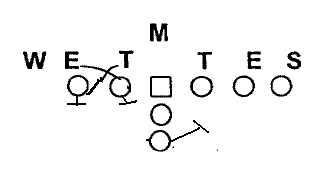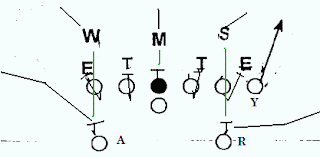Pass protection is a deep and varied subject, but at least a little can be said to understand the very high-level basics of how the pass rush/pass protection chess match plays out on a given play. Essentially, there are two types of protection schemes: (1) area or zone schemes, and (2) man schemes. Some protections blend these two approaches, either explicitly or implicitly.

(1) Area Schemes: An area scheme is where a group of blockers set up in a given area and then sort and pick-up whatever “trash” comes through. For example, if the center, guard, and tackle are responsible for one side of the protection, and the defense crosses and twists a couple defensive linemen and a linebacker, the blockers will take the one that enters their area. This is probably the soundest “protect-first” approach, and good teamwork will allow the line to deal with defensive creativity with a simple sound approach.

Problems with area schemes arise when you introduce runningbacks, tight ends, or H-backs into the equation. The problem is twofold:
(a) An area scheme could leave you with a terrible match-up, such as a runningback on a defensive end (or Lawrence Taylor).
(b) An area-assigned protector who is also a skill player (like a tight end, H-back, or runningback) has a difficult time releasing into the route if the defense does not blitz. So any of those skill players who you have assigned to an area scheme likely will not get out into the route, and you might only have three receivers trying to get open against seven pass defenders. For example, see the diagram below, where the tight-end and runningback (both skill players and potential receivers) end up in the pass route while the center and right-tackle end up blocking no one at all.

More specifically, the guard, tackle, and Y (TE) are playing an area scheme, making them responsible for the defensive tackle, the defensive end, and the stronside linebacker (Sam or “S”). Although we could handle a stunt or twist, with the middle and strongside linebackers dropping into coverage the tight-end and potentially the runningback have to protect, while interior linemen block no one. Indeed, the tight-end ends up blocking the defensive end, a potential mismatch. There are ways around this problem, but it is a definitely concern.
The most common “area” protection is slide or “gap” protection, where the line all slides to a gap. More on this in a moment.
(2) Man Schemes: The offensive front identifies their counterparts on defense and blocks them where they go. This is not an absolute “man scheme” — typically linemen will still employ a modified area scheme (where they will trade defenders who twist) while running backs, because they are set back further away from the line, can go where their counterpart goes easier than a lineman. But the principle is that each player has to win his own personal one-on-one matchup. In the diagram below, the runningback is assigned to the Weak (“W”) linebacker on a “man” principle. Wherever he goes, he is responsible for blocking him. If Will does not rush, the RB will release into the pass route. Similarly, H is responsible for the Strongside linebacker (“S”), and if he does not rush, then H will release into the route.

Man blocking seeks to eliminate the problems we identified with area schemes: as in the diagram above, a “BOB” approach – short for “Big on Big” and “Back on Backer.” The idea is that the linemen will take the big defensive linemen (who also tend to rush the passer on most plays), while the runningbacks or H-Backs will block the linebackers, who are both more their size and less likely to rush the passer than a defensive lineman. So you avoid both area scheme problems: the matchups should be better for the offense and, if the defense only rushes three or four, your skill guys can still get out into the route.

(3) Combo protection: An extremely common protection is to area block one side of the line and man block the other side, typically the side with the runningback. There is some dissension among coaches, but my view is that almost all six-man protections end up with something similar to this concept, whether they do it explicitly (as I advocate) or implicitly, as others do. The idea is that most teams find it advantageous to teach their linemen to area block stunts and twists, so you wind up with a combo concept. In any event, combination protection employs my preferred form of “area” or “zone” protection, which is the “slide” or “gap” protection mentioned earlier. Each area-blocker “slides” to the gap away from the callside. I advocate a “full-slide” for many quick game routes, but below is the half-slide, which is the most useful and versatile protection I’m aware of.
The base rules for this protection are as follows: Linemen to the callside (i.e. where the runner is going) block the defender over them until the first bubble (i.e. the first uncovered linemen, though the term “bubble” helps prevent against confusion due defensive players stunting). In the diagram above the first uncovered lineman is the center. From the uncovered bubble to the backside the other will linemen will all slide away from the callside to that gap, and will “pick up trash”. For example, versus a standard four man front, with the center uncovered, the center, backside guard and tackle will slide that way. The playside guard and tackle will block man on. The runningback blocks the linebackers inside to out, from the bubble to outside rusher (or, put in jargon terms, “Mike to Sam”). If those guys don’t rush the runner releases.
This last bit is another important protection concept: the dual-read. The dual-read is simply where a single blocker is responsible for two-men: if one rushes, he gets blocked; if one doesn’t rush and two rushes, the blocker must wheel out and block them; but if they both rush, the blocker takes the most urgent threat (the inside blitzer) but the quarterback must know he has to throw hot or throw it away (or run like hell). For a runningback, this is actually not too difficult to read because, being in the backfield, he can see all of it happen. In the 1980s and for much of the 1990s, however, it was common to also have linemen — typically the guard — also dual read, but the practice has significantly died out due to the difficulties presented as a result of the zone blitz and increased athleticism of defenders.
Of course, for pass protection to work the burden cannot solely be laid at the feet of the offensive linemen. Most — if not almost all — are the quarterback’s fault, as the ball must be gone on time or else the rate of sacks skyrockets. Moreover, coaches must be intelligent in how they call a game with respect to the pass rush: If all an offensive coordinator calls are dropback passes, then the defense is essentially taking target practice at a stationary target. The trick is instead to use roll-out passes, screens, quick passes, draws, traps, and various play-actions, in addition to traditional dropbacks, to put the quarterback and linemen in position to succeed.

Additional reading:
